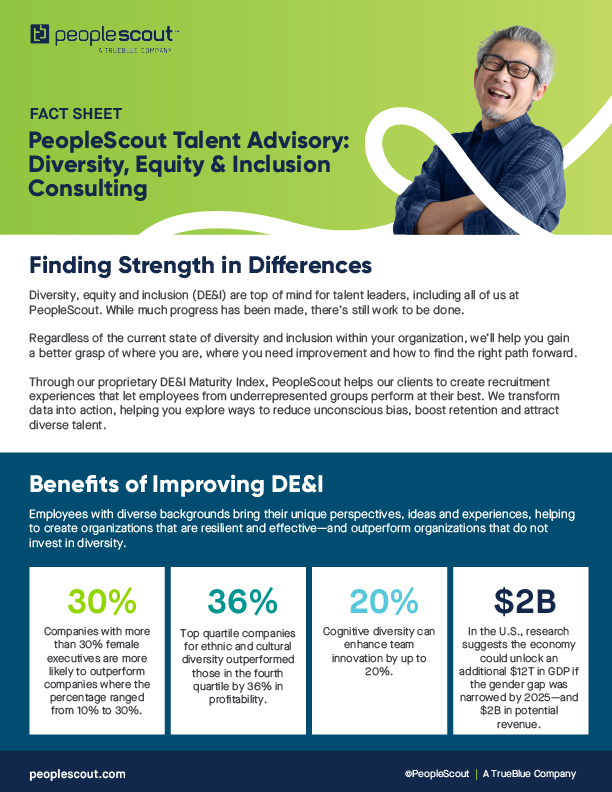By Simon Wright, Global Head of Talent Advisory Consulting
Consumer marketers have honed their brand strategies through decades of tracking detailed customer analytics, optimizing digital experiences and crafting emotionally compelling messages. When it comes to leveraging data and analytics, consumer marketing is ahead of employer branding. But it doesn’t have to be that way!
Talent acquisition pros can adapt these same tactics to understand candidates, polish touchpoints and build strong employer brands. Your employer brand can steal a page from the consumer brand playbook to step up talent attraction and retention.
Hacking the Employer Brand: 10 Tricks from Consumer Marketing
To help you think outside the recruitment box, we’ve outlined 10 employer brand hacks below to infuse your candidate attraction strategy with consumer-savvy flair. From mystery shoppers to NPS surveys, these creative approaches will revolutionize your talent attraction strategy.
1. Engagement Analytics
Consumer Brand Best Practice: Measure engagement metrics on ecommerce and social platforms to gauge product resonance.
Employer Brand Hack: Consumer marketing is as much science as it is art these days. Take page from your marketing peers and leverage analytics tools to monitor engagement levels with your content across digital platforms and third-party sites. You can gain valuable insights into how potential candidates perceive your employee value proposition (EVP) by monitoring the types of content that talent interacts with on sites like LinkedIn and your career pages.
For example, heavy traffic and shares of content spotlighting your company’s flexible work options, learning and development programs or commitment to DE&I indicates these subjects are important to candidates. Likewise, you can identify red flags where pieces of your EVP are falling flat or even turning candidates away.
By analyzing these engagement metrics, talent acquisition teams can refine outward-facing messaging to better reflect and emphasize the cultural elements already igniting passions.
2. Sentiment Analysis
Consumer Brand Best Practice: Analyze customer conversations on social media to gauge sentiment around products.
Employer Brand Hack: Job forums and social media channels have become backchannel focus groups, where in-the-know candidates exchange intel and impressions of potential employers. The everyday dialogue happening online shapes perceptions of your organization and EVP outside your control. Are you listening?
Immerse yourself in these dynamic discussions by using social listening tools to assess the narratives being woven about your company culture and their sentiment. Pay special attention to the emotional tone. What feelings are sparked at the mention of your organization? Is it warmth, intrigue and affinity? Or perhaps skepticism, frustration or even antagonism?
These unfiltered insights should inform your talent marketing strategy in real-time. Where positivity and praise emerge, double down on those messages. When you uncover misconceptions, course correct. Talent will continue to chatter, but plugged-in talent leaders can help guide the tone.
3. Feedback and Review Platforms
Consumer Brand Best Practice: Closely monitor customer reviews on sites like Amazon or Trustpilot.
Employer Brand Hack: Employer review platforms like Glassdoor, Indeed or kununu have become gold mines for candid insights directly from current and former employees. Monitoring these key sites should be a standard pulse-check for talent acquisition leaders and CHROs alike. But be warned—this is where you’ll find the unvarnished truth.
One way to improve your employer brand is through employer review sites. We recommend a quarterly audit digging into themes and analyzing sentiment over time. Are certain departments or practices called out repeatedly? Do some locations have better scores than others?
Used strategically, these insights provide CEOs, talent acquisition leaders and hiring managers at every level with an unfiltered mirror into the inner workings of company culture as employees are actively experiencing it. With this invaluable intelligence in hand, you can address problem spots through policy change or manager coaching. You can also double down on what’s working—the perks, flexibility, and cultural elements making employees stay.
4. Net Promoter Score (NPS)
Consumer Brand Best Practice: Use NPS to gauge product loyalty and word-of-mouth potential.
Employer Brand Hack: Implementing employee NPS (eNPS) and candidate NPS (cNPS) surveys offers a valuable pulse check for recruitment and retention alike.
With existing employees, these surveys quantify the likelihood of recommending your organization as a workplace. Low scores signal disengagement. Likewise, surveying candidates during the recruitment journey provides an understanding where expectations aren’t matching up with realities, helping you to refine your talent screening practices. Candidate NPS surveys can be sent post-interview and again post-onboarding for insights into both the recruitment and induction process.
Your employer brand health hinges on aligning the candidate experience with the employee experience and delivering on your brand promises throughout the talent lifecycle. Both eNPS and cNPS metrics offer evidence-based insights to inform your talent program strategy.
How does your Candidate Experience Quotient stack up? Learn all about our new method of calculating candidate experience as well as the hard truth about candidate expectations versus reality in our report, Inside the Candidate Experience.
5. Focus Group Discussions
Consumer Brand Best Practice: Dive deep into consumer preferences using focus groups.
Employer Brand Hack: When was the last time you picked the brains of candidates who have recently been through your recruitment process? As you refine your employer branding strategy and before you evolve your candidate experience, these individuals offer invaluable, straight-from-the-source insights.
In addition to surveys, organize quarterly listening sessions with a mix of talent segments: recent new hires, employees in their first year, candidates who made it to advanced stages but ultimately declined offers, and even short-listers you opted not to hire. In a judgment-free environment, empower them to share candid impressions about their journey with your organization pre- and post-hire.
Use this time to dig deep. What excited or deterred them about your employer brand initially? How did the interview or communication style align with their expectations of company culture? What workplace elements inspire their loyalty or doubts now as employees? Are perceptions consistent or disparate across genders, generations and ethnic groups?
These focus groups go beyond what a survey can fully capture. As a result, you can pinpoint what’s resonating or missing the mark in talent attraction, selection and retention. Bonus—it also demonstrates that employee input spurs action.
6. Mystery Shopping
Consumer Brand Best Practice: Deploy individuals to assess the customer experience—incognito.
Employer Brand Hack: Another way to get the insider perspective on your candidate experience is to use an old trick from consumer marketing—mystery shoppers. This involves engaging individuals to navigate the recruitment process undercover, reporting on their experience from start to finish.
Equip your “mystery shopper” to navigate the application, screening and interviews as authentically as possible, jotting detailed notes along the way. Instruct them to assess logistics around communication cadence, process efficiency and technology glitches. But more importantly, they should capture the emotional highs and lows they felt when interacting with your employees, content and brand at each step.
When you debrief, try to uncover interactions where your employer brand deviates from the actual experience across key variables like location, department, seniority level and demographic background. These behind-the-scenes findings will prove invaluable as you seek to optimize recruitment ROI and evolve the candidate journey.
7. Competitive Analysis
Consumer Brand Best Practice: Assess the brand vis-à-vis competitors.
Employer Brand Hack: Benchmark your employer brand against competitors to grasp areas of strength and improvement.
In today’s transparent talent marketplace, candidates have unprecedented visibility into everything from compensation to culture at your organization as well as your closest rivals. They are comparing you on everything from your work environment to DE&I commitments.
This means your employer brand strategy can no longer happen in a silo. Formal competitive intelligence monitoring can help you benchmark your employer brand against competitors to understand strengths and opportunities.
Audit the career sites, social media channels, job boards, industry reports and review site profiles of competitors to understand what messages and claims they’re leaning into with their employer brand. The goal here is not copying others’ employer brands but to understand how you can stand out and where you can bring sharper focus to what makes your culture uniquely attractive.
8. Deep Dives into Unstructured Feedback
Consumer Brand Best Practice: Sift through customer service calls and chats to identify common themes.
Employer Brand Hack: In their focus on surveys, employer review sites and focus groups, talent acquisition leaders often overlook the wealth of qualitative feedback hiding in plain sight internally.
Sources like exit interviews, town hall meetings and other internal platforms can offer genuine glimpses into how employees view your employer brand. You’ll uncover grounded narratives around things like which leaders inspire employee pride or skepticism, or real-talk on workloads affecting mental health and work-life balance.
This intelligence takes your employer brand strategy from reactive to proactive. It empowers you to intervene early before issues become viral Glassdoor threads. But just as importantly, you can also double down on what’s working, giving you an informed perspective to guide messaging, policy and experience in sync with employee values and expectations.
9. Audience Segmentation
Consumer Brand Best Practice: Segment the customer base to tailor messaging and understand perception among different audiences.
Employer Brand Hack: Employee perceptions within departments, roles, locations and tenure lengths often vary more than we realize. What engages your engineers may disengage your creatives. What excites recent college hires may fall flat for senior leaders.
In today’s fragmented but transparent talent marketplace, one-size-fits all employer branding is no longer effective. By investing time and effort into audience segmentation, CHROs take big step in evolving their EVP to PVP, personal value proposition.
Like customer personas, developing talent personas are a great way to engage in a targeted, personalized approach to talent attraction. These nuanced profiles allow you to sharpen your employer brand and talent attraction content for niche talent pools beyond one generic EVP message. Plus, you can tailor by regional expectations, whether in different cities in the same country or across continents.
Getting segmentation right ensures candidates see your employer brand as a match for people like them from the start.
10. User Behavior Analytics
Consumer Brand Best Practice: Understand how customers interact with their website or app by using user analytics tools like heatmaps.
Employer Brand Hack: Consumer marketing teams are increasingly adopting digital analytics tools to better understand customer preferences and behavior. Talent acquisition leaders can borrow this tactic too. Tools like heatmaps and click maps offer visual snapshots tracking precisely how users navigate and scroll career pages. These visual activity maps identify which content generates the most interest or engagement on your career site.
Lingering on the mission statement? Scrolling past office photos? Double-tapping into stories on career mobility but glossing over benefits? These granular insights reveal which candidate attraction content holds the greatest appeal for your candidates.
By understanding where your high-traffic areas and natural user flows are, you can guide candidates with attention-grabbing messages or entry points to more in-depth information. Likewise, you can weave in more stories around topics that are proving popular to leverage that momentum. These tools can also flag areas of friction, like errors or “rage clicks,” that could lead to candidates abandoning their application or leaving your career site.
Employer Brand Strategy: The Value of Data
Data and insights should always be the bedrock beneath an employer brand. Take time to gather feedback, analyze findings and track the impact of new initiatives. Don’t be afraid to experiment with new perspectives and unconventional approaches to stand out from the crowd.
With the right balance of boldness and research, you can craft a magnetic employer brand that both resonates with candidates and drives critical recruitment metrics. So, take a cue from your marketing peers—be brave, think big, and transform employer branding into a discipline as sophisticated as consumer marketing.



![[On-Demand] The Human Advantage: Redefining Employer Value Proposition for the New World of Work](https://www.peoplescout.com/wp-content/uploads/2023/11/PS-1265_The-Human-Advantage-Webinar-Promo-Materials_social_images-12-320x320.jpg)



